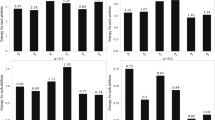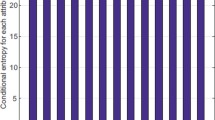Abstract
A set-valued information system (SVIS) is the generalization of a single-valued information system. A SVIS with missing information values is called an incomplete set-valued information system (ISVIS). This paper focuses on studying uncertainty measurement for an ISVIS with application to attribute reduction. First, the similarity degree between information values on each attribute is presented in an ISVIS. Then, the tolerance relation induced by each subsystem is given and rough approximations based on this relation is considered. Next, some tools to measure the uncertainty of an ISVIS are put forwarded. Moreover, the validity of the proposed measures is analyzed from the statistical point of view. Finally, information granulation and information entropy are applied to attribute reduction, the incomplete rate is adopted, and the effectiveness under different incomplete rates is analyzed and verified by k-means clustering algorithm and Mean Shift clustering algorithm.





































































Similar content being viewed by others
References
Calinski TT, Harabasz J (1974) A dendrite method for cluster analysis. Commun Stat 3(1):1–27
Chen LL, Chen DG, Wang H (2019) Fuzzy kernel alignment with application to attribute reduction of heterogeneous data. IEEE Trans Fuzzy Syst 27:1469–1478
Chen LJ, Liao SM, Xie NX, Li ZW, Zhang GQ, Wen CF (2020) Measures of uncertainty for an incomplete set-valued information system with the optimal selection of subsystems: Gaussian kernel method. IEEE Access 8:212022–212035
Chen ZC, Qin KY (2010) Attribute reduction of set-valued information systems based on a tolerance relation. Comp Sci 23(1):18–22
Chen XW, Xu WH (2021) Double-quantitative multigranulation rough fuzzy set based on logical operations in multi-source decision systems. Int J Mach Learn Cybern. https://doi.org/10.1007/s13042-021-01433-2
Cornelis C, Jensen R, Martin GH, Slezak D (2010) Attribute selection with fuzzy decision reducts. Inf Sci 180:209–224
Couso L, Dubois D (2014) Statistical reasoning with set-valued information: Onticvs. Epistemic views. Int J Approx Reason 55:1502–1518
Dai JH, Tian HW (2013) Entropy measures and granularity measures for set-valued information systems. Inf Sci 240:72–82
Davies DL, Bouldin DW (1979) A cluster separation measure. IEEE Trans Pattern Anal Mach Intell 2:224–227
Delgado A, Romero I (2016) Environmental conflict analysis using an integrated grey clustering and entropy-weight method: a case study of a mining project in Peru. Environ Modell Softw 77:108–121
Duntsch I, Gediga G (1998) Uncertainty measures of rough set prediction. Artif Intell 106:109–137
Friedman M (1940) A comparison of alternative tests of significance for the problem of m rankings. Ann Math Stat 11(1):86–92
Giang NL, Son LH, Ngan TT, Tuan TM, Phuong HT, Abdel-Basset M, de Macdo ARL, de Albuquerque VHC (2020) Novel incremental algorithms for attribute reduction from dynamic decision tables using hybrid filter-wrapper with fuzzy partition distance. IEEE Trans Fuzzy Syst 28:858–873
Hempelmann CF, Sakoglu U, Gurupur VP, Jampana S (2016) An entropy-based evaluation method for knowledge bases of medical information systems. Expert Syst Appl 46:262–273
Huang YY, Li TR, Lou C, Fujita H, Horng SJ (2017) Dynamic variable precision rough set approach for probabilistic set-valued information systems. Knowl-Based Syst 122:1–17
Leung Y, Fischer MM, Wu WZ, Mi JS (2008) A rough set approach for the discovery of classification rules in interval-valued information systems. Int J Approx Reason 47:233–246
Li JH, Kumar CA, Mei CL, Wang XH (2017) Comparison of reduction in formal decision contexts. Int J Approx Reason 80:100–122
Li ZW, Wang ZH, Song Y, Wen CF (2021) Information structures in a fuzzy set-valued information system based on granular computing. Int J Approx Reason 134:72–94
Li BZ, Wei ZH, Miao DQ, Zhang N, Shen W, Gong C, Zhang HY, Sun LJ (2020) Improved general attribute reduction algorithms. Inf Sci 536:298–316
Li WT, Xu WH, Zhang XY, Zhang J (2021) Updating approximations with dynamic objects based on local multigranulation rough sets in ordered information systems. Artif Intell Rev. https://doi.org/10.1007/s10462-021-10053-9
Liu Y, Zhong C (2016) Attribute reduction of set-valued decision information system based on dominance relation. J Interdiscip Math 19(3):469–479
Navarrete J, Viejo D, Cazorla M (2016) Color smoothing for RGB-D data using entropy information. Appl Soft Comput 46:361–380
Pawlak Z (1982) Rough sets. Int J Comput Inf Sci 11:341–356
Pawlak Z (1991) Rough sets: theoretical aspects of reasoning about data. Kluwer Academic Publishers, Dordrecht
Qian YH, Liang JY, Dang CY (2008) Set ordered information systems. Comput Math Appl 56:1994–2009
Qian YH, Liang JY, Pedrycz W, Dang CY (2010) An accelerator for attribute reduction in rough set theory. Artif Intell 174:597–618
Rouseeuw PJ (1987) Silhouettes: a graphical aid to the interpretation and validation of cluster analysis. J Comput Appl Math 20:53–65
Shannon CE (1948) A mathematical theory of communication. Bell Syst Tech J 27:379–423
Singh S, Shreevastava S, Som T, Somani G (2020) A fuzzy similarity-based rough set approach for attribute selection in set-valued information systems. Soft Comput 24:4675–4691
Song XX, Zhang WX (2009) Knowledge reduction in set-valued decision information system. Rough Sets Curr Trends Comput Proc 7260(1):348–357
Tang L, Wang Y, Mo ZW (2007) Knowledge reduction in set-valued incomplete information system. J Sichuan Normal Univ 30(3):288–290
Wang CZ, Huang Y, Ding WP, Cao ZH (2021) Attribute reduction with fuzzy rough self-information measures. Inf Sci 549:68–86
Wang CZ, Huang Y, Shao MW, Chen DG (2019) Uncertainty measures for general fuzzy relations. Fuzzy Sets Syst 360:82–96
Wang CZ, Huang Y, Shao MW, Fan XD (2019) Fuzzy rough set-based attribute reduction using distance measures. Knowl-Based Syst 164:205–212
Wang H, Yue HB (2016) Entropy measures and granularity measures for interval and set-valued information systems. Soft Comput 20:3489–3495
Wierman MJ (1999) Measuring uncertainty in rough set theory. Int J Gen Syst 28:283–297
Wu ZJ, Wang H, Chen N, Luo JW (2021) Semi-monolayer covering rough set on set-valued information systems and its efficient computation. Int J Approx Reason 130:83–106
Xie NX, Liu M, Li ZW, Zhang GQ (2019) New measures of uncertainty for an interval-valued information system. Inf Sci 470:156–174
Xie XL, Li ZW, Zhang PF, Zhang GQ (2019) Information structures and uncertainty measures in an incomplete probabilistic set-valued information system. IEEE Access 7:27501–27514
Xie SD, Wang YX (2014) Construction of tree network with limited delivery latency in homogeneous wireless sensor networks. Wireless Pers Commun 78(1):231–246
Xu WH, Guo YT (2016) Generalized multigranulation double-quantitative decision-theoretic rough set. Knowl-Based Syst 105(1):190–205
Xu WH, Li WT (2016) Granular computing approach to two-way learning based on formal concept analysis in fuzzy datasets. IEEE Trans Cybern 46(2):366–379
Xu WH, Yu JH (2017) A novel approach to information fusion in multi-source datasets: a granular computing viewpoint. Inf Sci 378:410–423
Xu WH, Yuan KH, Li WT (2022) Dynamic updating approximations of local generalized multigranulation neighborhood rough set. Appl Intell. https://doi.org/10.1007/s10489-021-02861-x
Yao YY (2003) Probabilistic approaches to rough sets. Expert Syst 20:287–297
Yao YY, Li XN (1996) Comparison of rough-set and set-set models for uncertain reasoning. Fund Inf 27:289–298
Yuan KH, Xu WH, Li WT, Ding WP (2022) An incremental learning mechanism for object classification based on progressive fuzzy three-way concept. Inf Sci 584(1):127–147
Zar JH (1972) Significance testing of the Spearman rank correlation coefficient. J Am Stat Assoc 67(339):578–580
Zhang GQ, Li ZW, Wu WZ, Liu XF, Xie NX (2018) Information structures and uncertainty measures in a fully fuzzy information system. Int J Approx Reason 101:119–149
Acknowledgements
The authors would like to thank the editors and the anonymous reviewers for their valuable comments and suggestions, which have helped immensely in improving the quality of the paper. This work is supported by National Natural Science Foundation of China (11971420), Natural Science Foundation of Guangxi (AD19245102, 2020GXNSFAA159155, 2018GXNSFDA294003), Key Laborabory of Software Engineering in Guangxi University for Nationalities (2021-18XJSY-03) and Special Scientific Research Project of Young Innovative Talents in Guangxi (2019AC20052).
Author information
Authors and Affiliations
Corresponding author
Additional information
Publisher's Note
Springer Nature remains neutral with regard to jurisdictional claims in published maps and institutional affiliations.
Rights and permissions
About this article
Cite this article
Song, Y., Luo, D., Xie, N. et al. Uncertainty measurement for incomplete set-valued data with application to attribute reduction. Int. J. Mach. Learn. & Cyber. 13, 3031–3069 (2022). https://doi.org/10.1007/s13042-022-01580-0
Received:
Accepted:
Published:
Issue Date:
DOI: https://doi.org/10.1007/s13042-022-01580-0




